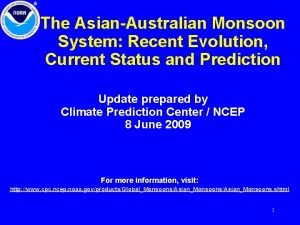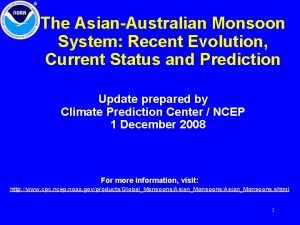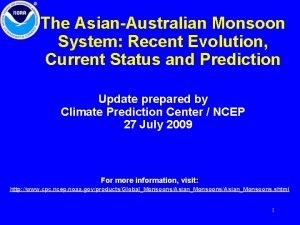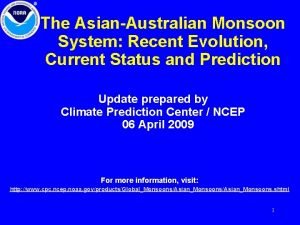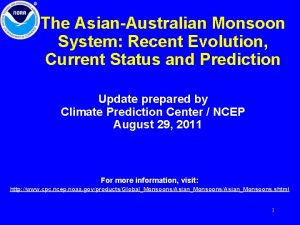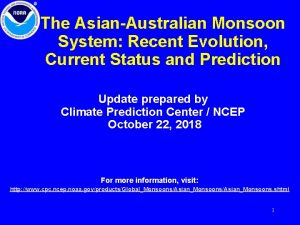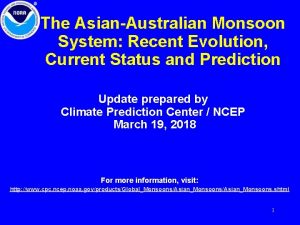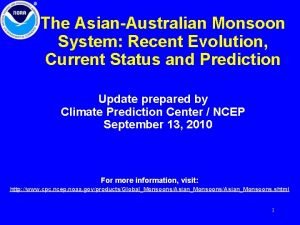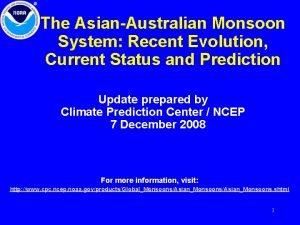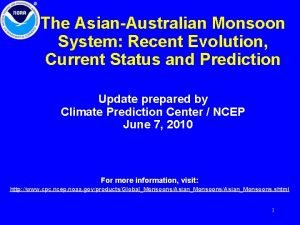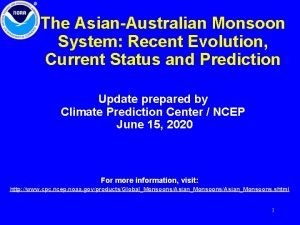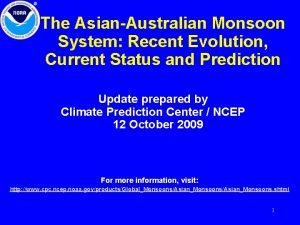The AsianAustralian Monsoon System Recent Evolution Current Status













- Slides: 13

The Asian-Australian Monsoon System: Recent Evolution, Current Status and Prediction Update prepared by Climate Prediction Center / NCEP 22 February 2010 For more information, visit: http: //www. cpc. ncep. noaa. gov/products/Global_Monsoons/Asian_Monsoons. shtml 1

Outline • Recent Evolution and Current Conditions • Monsoon Prediction • Summary • Climatology 2

Precip Patterns: Last 90 Days During the past 90 days, below-average precipitation was observed over much of the tropical Asian-Australian monsoon region and Madagascar. On the other hand, aboveaverage precipitation appeared over tropical Indian Ocean, southern South China Sea, the Arafura Sea, and equatorial western Pacific Ocean. 3

Precip Patterns: Last 30 Days During the past 30 days, below-average precipitation was observed over the tropical Asian-Australian monsoon region, especially over northern Australia and the Caroline Islands, and Madagascar. Above-average precipitation was seen over eastern Australia, East Asia, and part of the tropical Indian Ocean 4

Precip Patterns: Last 5 Days Below-average precipitation was found over much of the Australian monsoon region, tropical western Pacific, southern China, Japan, and Madagascar. Aboveaverage precipitation was observed over part of the tropical southern Indian Ocean. 5

Rainfall Time Series over 5 x 5 lat-lon boxes *This unified land-only daily precipitation dataset is different from the CMAP dataset used in the previous three spatial maps. Under the influence of El Nino, precipitation was mostly below average as large-scale features of below-average precipitation appeared over the tropical Asian-Australian monsoon region. 6

Atmospheric Circulation The lower-tropospheric westerly monsoon flow over northern Australia and equatorial Southeast Asia was weaker than normal. An anomalous cyclonic pattern appeared over the East China Sea. 7

NCEP/GFS Model Forecasts Bias-Corrected Precip. Anom. for Weak 1 & Week 2 Week-1 Week-2 8

Prediction of East Asia – NW Pacific Monsoon Upper panel: East Asia – Western North Pacific (EAWNP) monsoon index (Wang et al. 2008) defined as U 850 (5 -15ºN, 40 -80ºE) – U 850 (20 -30ºN, 70 -90ºE). Positive (negative) values indicate strong (weak) than normal monsoon. The NCEP Global Forecast System predicts that, in the next two weeks, the monsoon circulation over Southeast Asia and northwestern Pacific will be overall near normal. Lower panel: Correlation between rainfall and East Asia – Western North Pacific monsoon index (Wang et al. 2008; shading) and regression of 850 -mb winds on the monsoon index (vectors) for March. Green (brown) shading indicates increase (decrease) in rainfall associated with strong monsoon. 9

Prediction of Australian Monsoon Upper panel: Australian monsoon index (Hung and Yanai 2004) defined as U 850 averaged over 2. 5ºS-15ºS, 110 -150ºE. Positive (negative) values indicate strong (weak) than normal monsoon. The NCEP Global Forecast System predicts that, in the next two weeks, the Australian monsoon circulation will be becoming stronger from a weak stage. Lower panel: Correlation between rainfall and Australian monsoon index (Hung and Yanai 2004; shading) and regression of 850 -mb winds on the monsoon index (vectors) for March. Green (brown) shading indicates increase (decrease) in rainfall associated with strong monsoon. 10

Summary • Below-average precipitation was found over much of the Australian monsoon region, tropical western Pacific, southern China, Japan, and Madagascar. Above-average precipitation was observed over part of the tropical southern Indian. • The NCEP Global Forecast System predicts that, in the next two weeks, the Australian monsoon circulation will be becoming stronger from a weak condition. 11

Retreat of the Australia Monsoon 12

Climatology 13
 Line current and phase current
Line current and phase current Power formula three phase
Power formula three phase Energy band diagram of pn junction diode
Energy band diagram of pn junction diode Line current and phase current
Line current and phase current Drift vs diffusion current
Drift vs diffusion current What is diffusion current and drift current
What is diffusion current and drift current The constant-current region of a fet lies between
The constant-current region of a fet lies between Balanced delta-delta connection
Balanced delta-delta connection Slideplayer
Slideplayer Drift current and diffusion current in semiconductor
Drift current and diffusion current in semiconductor Why is sma welding current referred to as constant current?
Why is sma welding current referred to as constant current? Touch current vs leakage current
Touch current vs leakage current Mesh current method with current source
Mesh current method with current source Current program status register is
Current program status register is














